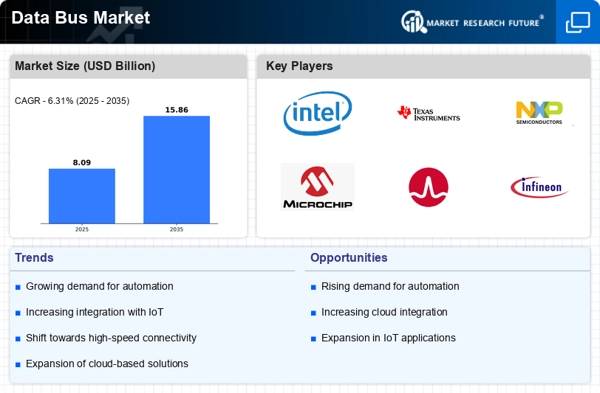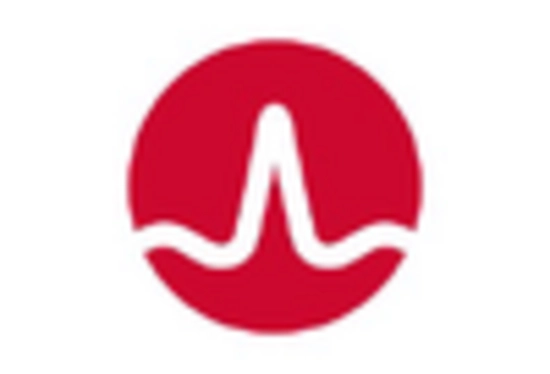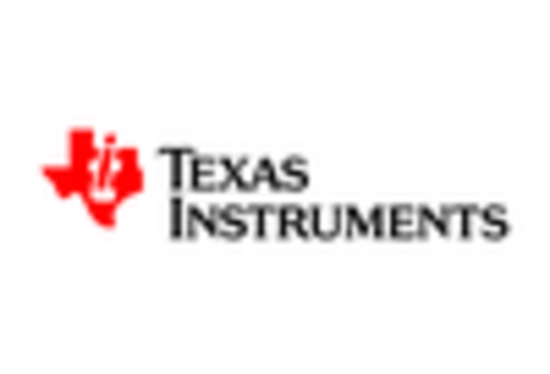Emergence of 5G Technology
The Data Bus Market is poised for transformation with the emergence of 5G technology. This next-generation wireless technology promises to revolutionize data transmission speeds and connectivity, thereby impacting various sectors reliant on data buses. The implementation of 5G networks is expected to facilitate the deployment of smart cities, autonomous vehicles, and advanced industrial applications, all of which require robust data communication frameworks. Analysts predict that the global rollout of 5G will create new opportunities for data bus manufacturers, as the demand for high-speed, low-latency communication solutions escalates. This technological advancement may lead to the development of innovative data bus architectures that can accommodate the increased data flow associated with 5G applications. As a result, the Data Bus Market is likely to witness significant growth driven by the widespread adoption of 5G technology.
Growing Focus on Data Security
The Data Bus Market is increasingly shaped by the growing focus on data security. As organizations become more aware of the risks associated with data breaches and cyber threats, the demand for secure data transmission solutions intensifies. This trend is particularly relevant in sectors such as finance, healthcare, and critical infrastructure, where the integrity of data is paramount. Companies are investing in advanced data bus technologies that incorporate robust security features to protect sensitive information during transmission. Furthermore, regulatory frameworks are evolving to address data protection concerns, compelling organizations to adopt secure data communication practices. As a result, the Data Bus Market is likely to experience growth driven by the need for secure and reliable data buses that can safeguard against potential vulnerabilities.
Expansion of Automotive Electronics
The Data Bus Market is significantly influenced by the expansion of automotive electronics. As vehicles become increasingly equipped with advanced electronic systems, the demand for reliable data buses to facilitate communication between these systems intensifies. The automotive sector is projected to witness a substantial increase in electronic content, with estimates suggesting that the average vehicle will contain over 100 electronic control units by 2025. This proliferation of electronics necessitates the use of sophisticated data bus architectures to ensure seamless data exchange. Furthermore, the shift towards electric and autonomous vehicles amplifies the need for high-performance data buses capable of handling complex data streams. As a result, the Data Bus Market is poised for growth, driven by the automotive sector's relentless pursuit of innovation and enhanced functionality.
Adoption of Smart Manufacturing Practices
The Data Bus Market is experiencing a transformation due to the adoption of smart manufacturing practices. Industries are increasingly integrating automation and data exchange technologies to enhance operational efficiency and productivity. The implementation of Industry 4.0 principles necessitates the use of advanced data buses that can support real-time communication between machines and systems. This shift is reflected in the growing investment in smart factories, with projections indicating that the smart manufacturing market will reach a valuation of over 300 billion dollars by 2026. As manufacturers seek to optimize their processes, the demand for reliable and high-speed data buses becomes critical. Consequently, the Data Bus Market is likely to benefit from this trend, as companies prioritize the development of interconnected systems that leverage data for improved decision-making.
Increased Demand for High-Speed Data Transmission
The Data Bus Market experiences a notable surge in demand for high-speed data transmission solutions. As industries increasingly rely on real-time data processing, the need for efficient data buses becomes paramount. This trend is particularly evident in sectors such as telecommunications and automotive, where the integration of advanced technologies necessitates rapid data transfer capabilities. According to recent estimates, the market for high-speed data buses is projected to grow at a compound annual growth rate of approximately 8% over the next five years. This growth is driven by the proliferation of smart devices and the Internet of Things, which require robust data communication frameworks. Consequently, manufacturers are compelled to innovate and enhance their data bus offerings to meet the evolving requirements of various applications, thereby propelling the Data Bus Market forward.

















Leave a Comment